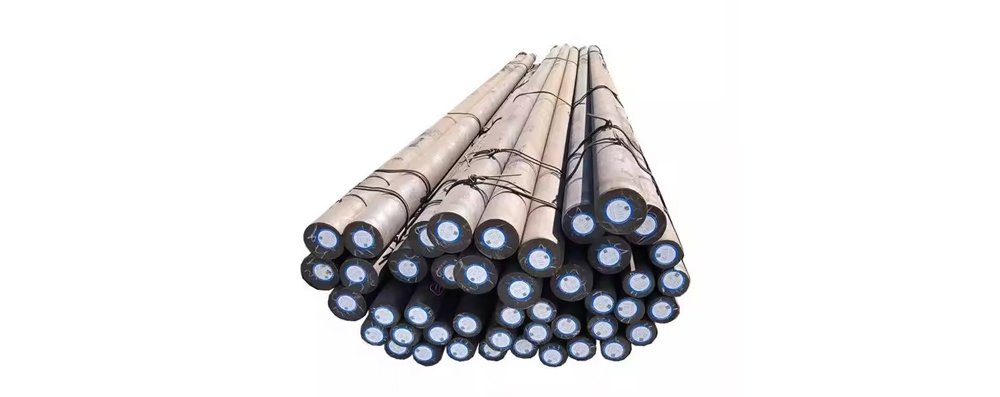Introduction
SAE 1010 carbon steel is a low-carbon, mild steel grade widely used for its excellent workability, weldability, and cost-effectiveness. It offers a good balance of strength and ductility, making it an ideal material for a wide range of industrial applications. SAE 1010 is primarily used where moderate strength and good formability are required.
Properties of SAE 1010 Grade:
- Excellent weldability and formability
- Good ductility and toughness
- Moderate tensile strength
- Easily machinable in the annealed condition
- Relatively inexpensive compared to alloy steels
Uses/Applications of SAE 1010 Grade:
- Automotive components (e.g., panels, structural parts)
- Machinery parts
- Pipes and tubes
- Fasteners
- Agricultural equipment
- Furniture frames
- Wire products
- Appliances and hardware
Chemical Composition (Typical):
| Element | Content (%) |
| Carbon (C) | 0.08 – 0.13 |
| Manganese (Mn) | 0.30 – 0.60 |
| Phosphorus (P) | ≤ 0.04 |
| Sulfur (S) | ≤ 0.05 |
| Iron (Fe) | Balance |
Mechanical Properties (Typical):
| Property | Value |
| Tensile Strength | 305 – 450 MPa |
| Yield Strength | 165 – 275 MPa |
| Elongation (in 50 mm) | 28 – 34% |
| Hardness (Brinell) | 95 – 120 HB |
Physical Properties:
| Property | Value |
| Density | 7.87 g/cm³ |
| Melting Point | ~ 1460 – 1520 °C |
| Modulus of Elasticity | ~ 200 GPa |
| Thermal Conductivity | 51.9 W/m·K |
| Electrical Conductivity | 10% IACS (approx.) |
Forging:
- SAE 1010 carbon steel can be forged between 1150 °C and 1250 °C.
- After forging, slow cooling in a furnace or under insulating materials is recommended to minimize the risk of internal stresses and potential cracking.
Heat Treatment:
- Annealing: Full annealing is performed at 870 °C to 980 °C followed by slow cooling.
- Normalizing: Normalizing at about 900 °C followed by air cooling can refine the grain size and improve machinability.
- Hardening: Not typically hardened by heat treatment due to low carbon content; surface hardening (e.g., carburizing) may be applied for specific requirements.
Dimensional Tolerances:
Dimensional tolerances of SAE 1010 steel bars conform to standard specifications such as ASTM A108 and A29. Tolerances depend on the bar size and condition (cold-drawn, hot-rolled, etc.). Typical tolerance examples:
- Cold drawn bars: ±0.001″ to ±0.003″
- Hot rolled bars: wider tolerances, depending on diameter.
- Stress Relieving: Heat at 540 °C to 650 °C to relieve residual stresses after welding or cold working.
Machinability:
SAE 1010 steel offers good machinability in the annealed condition but may require sharp tools and proper cooling due to its tendency to produce long, continuous chips. Its machinability rating is approximately 55% relative to SAE 1112 steel.
Corrosion Resistance:
SAE 1010 carbon steel does not have inherent corrosion resistance and will oxidize if exposed to moist or corrosive environments. Proper coatings, painting, or galvanizing are recommended for corrosion protection when used in exposed conditions.
Weldability:
SAE 1010 has excellent weldability by all conventional methods including:
- Arc welding
- Gas welding
- Resistance welding
Preheating is typically not necessary for welding, but post-weld heat treatment might be required for critical applications to avoid residual stresses.
Available Form:
- Round Bars
- Square Bars
- Flat Bars
- Hexagonal Bars
- Wire Rods
- Coils
- Cut-to-size customized profiles
Available in both hot-rolled and cold-drawn conditions.
Conclusion:
SAE 1010 carbon steel bar is a highly versatile material known for its excellent formability, good weldability, and adequate strength. It finds extensive use in automotive, machinery, and general engineering sectors. Its adaptability to forging, welding, and machining processes makes it a preferred choice for many industrial applications. Although it lacks corrosion resistance, protective treatments can easily extend its service life in adverse environments.
Related Products :20C8, ASTM A36, 20MN2, 55C8, 40C8, C45, ASTM SA-105, C50, C20, C55, EN3B, C55 Mn2, C60, C45, EN9, EN8, EN8D, IS 2062, EN43B, S355J2G3, S40C, SAE 1010, SAE 1018, ST52.3, 20MN2, Maps


